

La Micronésie - L'appel de l'ailleurs. Guam. Guam ( i/ˈɡwɑːm/ or /ˈɡwɒm/; Chamorro: Guåhån) is an organized, unincorporated territory of the United States in the western Pacific Ocean.
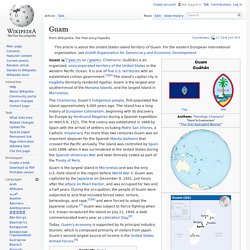
It is one of five U.S. territories with an established civilian government.[3][4] The island's capital city is Hagåtña (formerly rendered Agaña). Guam is the largest and southernmost of the Mariana Islands, and the largest island in Micronesia. Guam is the largest island in Micronesia and was the only U.S. -held island in the region before World War II. Today, Guam's economy is supported by its principal industry, tourism, which is composed primarily of visitors from Japan.
History[edit] The original inhabitants of Guam and the Northern Mariana Islands are believed to be descendents of Austronesian people originating from Southeast Asia as early as 2000 BC.[10]:16 These people evolved into the Chamorro people. Spanish colonization and the Manila galleons[edit] Spanish–Chamorro War[edit] Capt. Northern Mariana Islands. This article is about the Commonwealth of the Northern Mariana Islands, a political entity.
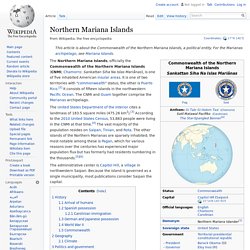
For the Marianas archipelago, see Mariana Islands. The administrative center is Capitol Hill, a village in northwestern Saipan. Because the island is governed as a single municipality, most publications consider Saipan the capital. History[edit] Arrival of humans[edit] The first people of the Mariana Islands immigrated at some point between 4000 BC to 2000 BC from Southeast Asia. The ancient people of the Marianas raised colonnades of megalithic capped pillars called latte stones upon which they built their homes. Archeologists in 2013 posited that the first people to settle in the Marianas may have made what was at that point the longest uninterrupted ocean-crossing voyage in human history, and that archeological evidence indicates Tinian may have been the first Pacific island outside of Asia to have been settled.[7] Spanish possession[edit] Wake Island.
Federated States of Micronesia. Island republic in Oceania Coordinates: The Federated States of Micronesia (/ˌmaɪkroʊˈniːʒə/ ( listen); abbreviated FSM and also known simply as Micronesia) is an independent republic associated with the United States.
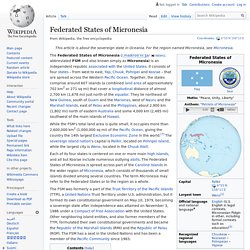
It consists of four states – from west to east, Yap, Chuuk, Pohnpei and Kosrae – that are spread across the Western Pacific Ocean. Palau. Palau ( i/pəˈlaʊ/, historically Belau or Pelew), officially the Republic of Palau (Palauan: Beluu er a Belau),[4] is an island country located in the western Pacific Ocean.

Nauru. Island country in the southwestern Pacific Ocean Nauru ( nah-OO-roo[5] or NOW-roo;[6] Nauruan: Naoero), officially the Republic of Nauru (Nauruan: Repubrikin Naoero) and formerly known as Pleasant Island, is an island country in Micronesia, a subregion of Oceania, in the Central Pacific.
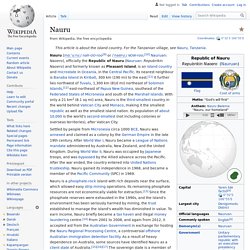
Its nearest neighbour is Banaba Island in Kiribati, 300 km (190 mi) to the east. It further lies northwest of Tuvalu, 1,300 km (810 mi) northeast of the Solomon Islands,[7] east-northeast of Papua New Guinea, southeast of the Federated States of Micronesia and south of the Marshall Islands. With only a 21 km2 (8.1 sq mi) area, Nauru is the third-smallest country in the world behind Vatican City, and Monaco, making it the smallest state in the South Pacific Ocean, the smallest state outside Europe, the smallest island state, and the smallest republic.
Additionally, its population of 10,670 is the world's third smallest, after Vatican City and Tuvalu. History[edit] Geography[edit] Climate[edit] Marshall Islands. The Marshall Islands, officially the Republic of the Marshall Islands (Marshallese: Aolepān Aorōkin M̧ajeļ),[note 1] is an island country located near the equator in the Pacific Ocean, slightly west of the International Date Line.
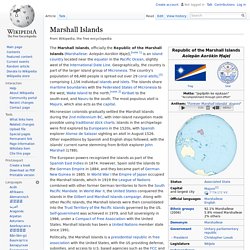
Geographically, the country is part of the larger island group of Micronesia. The country's population of 68,480 people is spread out over 29 coral atolls,[3] comprising 1,156 individual islands and islets. Kiribati. Kiribati (/ˌkɪrɪˈbæs/; KEER-ə-bahss or /ˌkɪrɪˈbɑːti/; KEER-ə-BAH-tee),[7] officially the Republic of Kiribati,[8][9][10][11][12] is an island nation in the central Pacific Ocean.
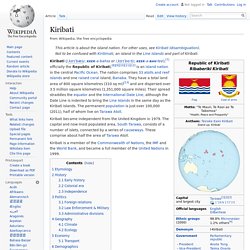
The nation comprises 33 atolls and reef islands and one raised coral island, Banaba. They have a total land area of 800 square kilometres (310 sq mi)[13] and are dispersed over 3.5 million square kilometres (1,351,000 square miles). Micronésie (région) Un article de Wikipédia, l'encyclopédie libre.

La Micronésie (« les petites îles ») est, avec la Mélanésie et la Polynésie, l'une des trois grandes régions que l'on distingue couramment en Océanie. La Micronésie comprend les États et régions administratives suivants : En 1831, Jules Dumont d'Urville propose à la Société de géographie de Paris de distinguer plusieurs régions dans l'Océanie : la Polynésie, « les nombreuses îles » ;la Mélanésie, « les îles noires » ;la Micronésie, « les petites îles » ;et la Malaisie (plus tard retirée). Cette distinction qui peut être qualifiée d'historique est désormais contestée[1] par les géographes et les océanistes. Les régimes politiques des Kiribati, de Nauru, des Palaos, des îles Marshall et de la Micronésie sont tous républicains. Les langues parlées en Micronésie (avant les colonisations européennes), appartiennent toutes à la branche malayo-polynésienne des langues austronésiennes.
Peuplement de l'Océanie. Micronesia. Map of Micronesia (shown in dark magenta) Micronesia (from Greek: μικρός, mikrós, "small" + Greek: νῆσος, nisos, "island") is a subregion of Oceania, comprising thousands of small islands in the western Pacific Ocean.
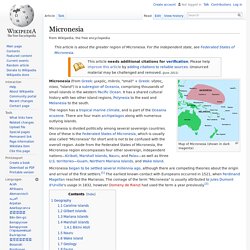
It has a shared cultural history with two other island regions, Polynesia to the east and Melanesia to the south. The region has a tropical marine climate, and is part of the Oceania ecozone. There are four main archipelagos along with numerous outlying islands. Micronesia is divided politically among several sovereign countries. Micronesia began to be settled several millennia ago, although there are competing theories about the origin and arrival of the first settlers. Geography[edit]